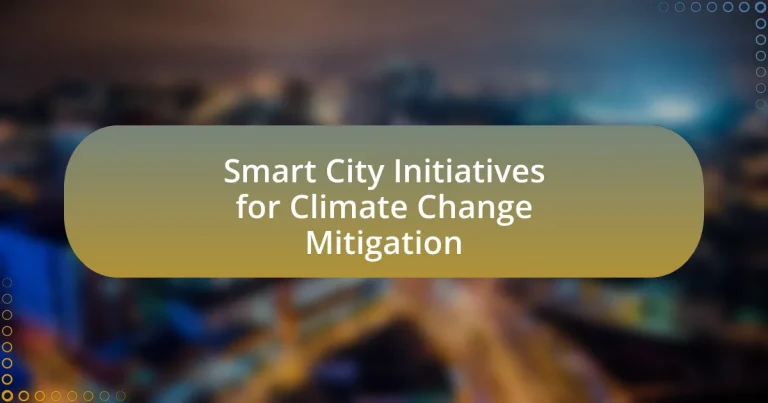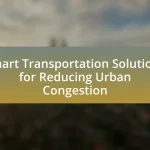Smart City Initiatives for Climate Change Mitigation refer to a variety of strategies designed to reduce greenhouse gas emissions and enhance urban resilience against climate impacts. Key strategies include the implementation of smart grids, promotion of electric and shared mobility, and integration of green infrastructure. The article explores how these initiatives address climate change through technology and data-driven solutions, highlighting successful examples from cities like Barcelona and Singapore. It also discusses the challenges faced in implementation, the importance of stakeholder collaboration, and the metrics used to evaluate success, emphasizing the role of community engagement and innovative practices in fostering sustainable urban environments.
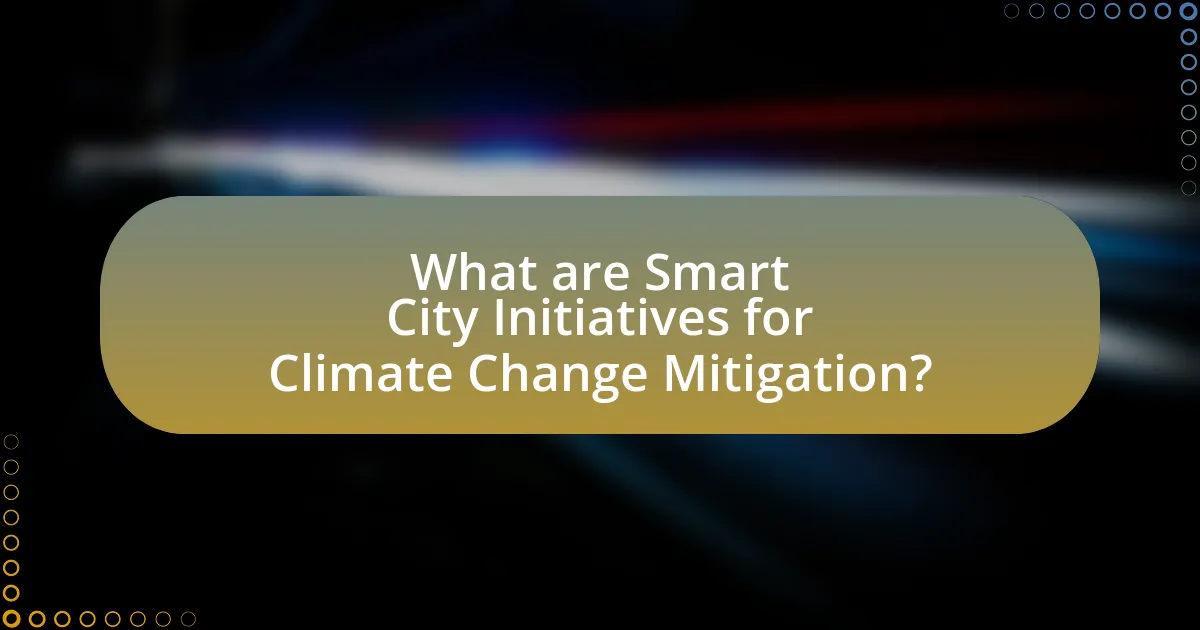
What are Smart City Initiatives for Climate Change Mitigation?
Smart City Initiatives for Climate Change Mitigation encompass a range of strategies aimed at reducing greenhouse gas emissions and enhancing urban resilience to climate impacts. These initiatives include the implementation of smart grids for efficient energy distribution, the promotion of electric and shared mobility solutions to decrease reliance on fossil fuels, and the integration of green infrastructure such as urban forests and green roofs to improve air quality and manage stormwater. For instance, cities like Barcelona have adopted smart lighting systems that adjust based on real-time data, reducing energy consumption by up to 30%. Additionally, the use of data analytics in urban planning helps optimize resource allocation and reduce waste, further contributing to climate change mitigation efforts.
How do Smart City Initiatives address climate change?
Smart City Initiatives address climate change by integrating technology and data-driven solutions to enhance urban sustainability and reduce greenhouse gas emissions. These initiatives implement smart grids, which optimize energy consumption and promote renewable energy sources, leading to a decrease in reliance on fossil fuels. For instance, cities like Barcelona have adopted smart lighting systems that adjust based on real-time data, reducing energy waste by up to 30%. Additionally, smart transportation systems, such as those in Singapore, utilize real-time traffic data to minimize congestion and lower vehicle emissions. By leveraging IoT sensors and big data analytics, Smart City Initiatives facilitate efficient resource management, ultimately contributing to climate change mitigation efforts.
What specific strategies are employed in these initiatives?
Smart city initiatives for climate change mitigation employ strategies such as the implementation of renewable energy sources, smart transportation systems, and enhanced waste management practices. These strategies aim to reduce greenhouse gas emissions and improve urban sustainability. For instance, cities like San Diego have integrated solar energy into their infrastructure, resulting in a 30% reduction in carbon emissions since 2010. Additionally, smart transportation systems, such as those in Amsterdam, promote electric vehicles and cycling, which significantly decrease reliance on fossil fuels. Enhanced waste management practices, exemplified by the zero-waste initiatives in Kamikatsu, Japan, aim to minimize landfill use and promote recycling, contributing to overall climate resilience.
How do these strategies vary across different cities?
Smart city initiatives for climate change mitigation vary significantly across different cities due to factors such as local governance, population density, economic resources, and environmental challenges. For instance, cities like Copenhagen focus on extensive cycling infrastructure and renewable energy sources, aiming for carbon neutrality by 2025, while cities like Los Angeles prioritize electric vehicle adoption and public transportation improvements to combat air pollution. Additionally, Singapore employs smart technology for water management and urban greenery, reflecting its unique geographical constraints and climate resilience goals. These variations illustrate how local contexts shape the specific strategies implemented to address climate change effectively.
Why are Smart City Initiatives important for sustainability?
Smart City Initiatives are important for sustainability because they leverage technology and data to enhance urban efficiency and reduce environmental impact. These initiatives promote energy efficiency, waste reduction, and improved public transportation, which collectively contribute to lower carbon emissions. For instance, cities implementing smart grids can optimize energy distribution, resulting in a 10-30% reduction in energy consumption, as reported by the International Energy Agency. Additionally, smart waste management systems can decrease landfill waste by up to 30% through optimized collection routes and recycling programs. Thus, Smart City Initiatives play a crucial role in fostering sustainable urban environments.
What role do they play in reducing carbon emissions?
Smart city initiatives play a crucial role in reducing carbon emissions by implementing technologies and strategies that enhance energy efficiency and promote sustainable practices. These initiatives often include the integration of smart grids, which optimize electricity distribution and reduce waste, and the deployment of intelligent transportation systems that minimize traffic congestion and lower vehicle emissions. For example, cities that have adopted smart traffic management systems have reported reductions in carbon emissions by up to 30% due to decreased idle times and improved traffic flow. Additionally, smart buildings equipped with energy management systems can reduce energy consumption by 20-50%, further contributing to lower overall carbon footprints.
How do they contribute to enhancing urban resilience?
Smart city initiatives enhance urban resilience by integrating technology and data-driven solutions to improve infrastructure, resource management, and community engagement. These initiatives, such as smart grids and real-time monitoring systems, enable cities to respond more effectively to climate-related challenges, reducing vulnerability to extreme weather events. For instance, cities utilizing smart water management systems can optimize water usage during droughts, thereby conserving resources and maintaining supply. Additionally, the implementation of green infrastructure, like urban forests and green roofs, mitigates flooding and heat island effects, further strengthening urban resilience against climate change impacts.
What challenges do Smart City Initiatives face in climate change mitigation?
Smart City Initiatives face significant challenges in climate change mitigation, primarily due to technological integration, funding limitations, and stakeholder engagement. Technological integration often encounters issues such as interoperability among various systems and the need for advanced infrastructure, which can hinder effective implementation. Funding limitations restrict the ability to invest in necessary technologies and projects, as many initiatives rely on public and private partnerships that may not materialize. Additionally, stakeholder engagement is crucial; differing priorities among government entities, businesses, and residents can lead to conflicts and slow progress. These challenges are compounded by the urgency of climate change, necessitating swift and coordinated action across multiple sectors.
What are the common barriers to implementation?
Common barriers to implementation of smart city initiatives for climate change mitigation include insufficient funding, lack of stakeholder engagement, and inadequate technological infrastructure. Insufficient funding often limits the scope and scale of projects, as many initiatives require significant investment for development and maintenance. Lack of stakeholder engagement can lead to resistance from communities and local governments, which is crucial for successful implementation. Inadequate technological infrastructure hinders the integration of smart solutions, as existing systems may not support new technologies or data-sharing capabilities. These barriers collectively impede progress in developing effective smart city strategies aimed at mitigating climate change.
How can these challenges be overcome?
Smart city initiatives can overcome challenges through integrated planning, stakeholder engagement, and leveraging technology. Integrated planning ensures that urban development aligns with sustainability goals, allowing cities to prioritize climate resilience in infrastructure projects. Stakeholder engagement, including collaboration with local communities, businesses, and government agencies, fosters a shared vision and collective action towards climate goals. Leveraging technology, such as smart sensors and data analytics, enables cities to monitor environmental impacts and optimize resource use, leading to more efficient energy consumption and reduced emissions. For instance, cities like Barcelona have implemented smart lighting systems that adjust based on real-time data, resulting in significant energy savings and lower carbon footprints.
How do Smart City Initiatives integrate technology for climate solutions?
Smart City Initiatives integrate technology for climate solutions by utilizing data analytics, IoT devices, and renewable energy systems to enhance urban sustainability. These initiatives deploy sensors and smart meters to monitor environmental conditions, optimize energy consumption, and manage waste efficiently. For example, cities like Barcelona use smart lighting systems that adjust based on real-time data, reducing energy use by up to 30%. Additionally, smart grids facilitate the integration of renewable energy sources, allowing for better management of energy distribution and consumption, which is crucial for reducing greenhouse gas emissions.
What technologies are most commonly used in these initiatives?
Smart city initiatives for climate change mitigation commonly utilize technologies such as Internet of Things (IoT) devices, big data analytics, renewable energy systems, and smart transportation solutions. IoT devices enable real-time monitoring of environmental conditions, while big data analytics helps in processing vast amounts of data to inform decision-making. Renewable energy systems, including solar panels and wind turbines, contribute to reducing carbon emissions. Smart transportation solutions, such as electric vehicles and intelligent traffic management systems, enhance urban mobility and decrease pollution levels. These technologies collectively support the goals of sustainability and resilience in urban environments.
How does data analytics enhance the effectiveness of these initiatives?
Data analytics enhances the effectiveness of smart city initiatives for climate change mitigation by providing actionable insights derived from large datasets. These insights enable city planners to identify patterns in energy consumption, traffic flow, and waste management, which are critical for optimizing resource allocation and reducing carbon footprints. For instance, a study by the International Council for Local Environmental Initiatives found that cities using data analytics can reduce greenhouse gas emissions by up to 30% through improved energy efficiency and smarter transportation systems. This demonstrates that data-driven decision-making directly contributes to more effective climate action strategies in urban environments.
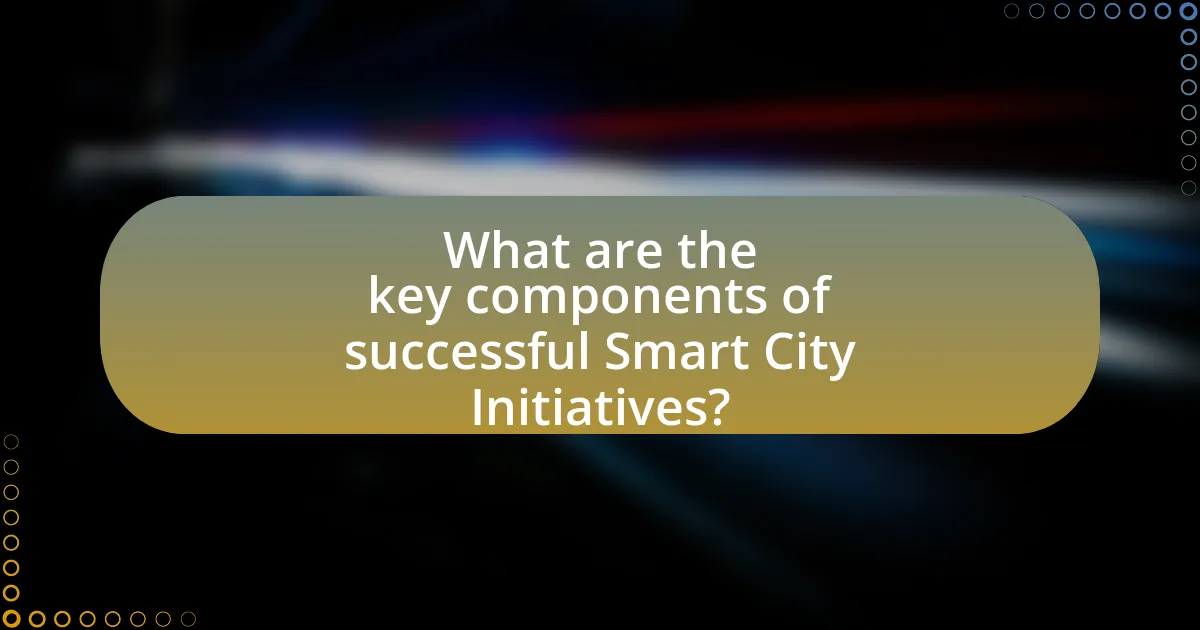
What are the key components of successful Smart City Initiatives?
The key components of successful Smart City Initiatives include integrated technology, data-driven decision-making, citizen engagement, sustainable infrastructure, and effective governance. Integrated technology enables seamless communication between various city systems, enhancing efficiency and responsiveness. Data-driven decision-making relies on real-time data analytics to optimize resource allocation and improve urban services. Citizen engagement fosters community involvement and ensures that initiatives meet the needs of residents. Sustainable infrastructure focuses on eco-friendly designs and renewable energy sources to reduce environmental impact. Effective governance involves collaboration among stakeholders, ensuring transparency and accountability in the implementation of smart city projects. These components collectively contribute to the resilience and adaptability of urban environments in the face of climate change challenges.
How do stakeholder collaborations influence these initiatives?
Stakeholder collaborations significantly enhance smart city initiatives for climate change mitigation by pooling resources, expertise, and diverse perspectives. These collaborations enable cities to implement comprehensive strategies that address climate challenges more effectively. For instance, partnerships between local governments, private sector companies, and community organizations can lead to innovative solutions such as integrated energy systems and sustainable transportation networks. Research shows that cities with strong stakeholder engagement, like Amsterdam, have successfully reduced carbon emissions by 25% through collaborative projects. This evidence underscores the critical role of stakeholder collaborations in driving impactful climate action within smart city frameworks.
What roles do government, private sector, and citizens play?
The government, private sector, and citizens each play crucial roles in smart city initiatives for climate change mitigation. The government establishes policies, regulations, and funding mechanisms that guide and support sustainable urban development, such as implementing renewable energy standards and promoting public transportation systems. The private sector contributes through innovation and investment in green technologies, such as smart grids and energy-efficient buildings, which help reduce carbon emissions. Citizens engage by participating in community programs, adopting sustainable practices, and advocating for environmental policies, thereby influencing local governance and fostering a culture of sustainability. Together, these roles create a collaborative framework essential for effective climate change mitigation in urban settings.
How can effective communication enhance stakeholder engagement?
Effective communication enhances stakeholder engagement by fostering transparency and trust, which are essential for collaborative efforts in smart city initiatives aimed at climate change mitigation. When stakeholders, including government entities, businesses, and community members, receive clear and consistent information, they are more likely to understand the goals and benefits of initiatives. Research indicates that projects with high stakeholder engagement are 30% more likely to succeed, as effective communication encourages participation and feedback, leading to better decision-making and resource allocation. This dynamic creates a sense of ownership among stakeholders, further driving commitment to climate action initiatives.
What funding mechanisms support Smart City Initiatives?
Funding mechanisms that support Smart City Initiatives include government grants, public-private partnerships, and international funding programs. Government grants, such as those from the U.S. Department of Transportation or the European Union, provide financial resources specifically aimed at enhancing urban infrastructure and sustainability. Public-private partnerships leverage investments from private entities to fund projects that improve city services and reduce carbon footprints. Additionally, international funding programs, like those from the World Bank or the United Nations, offer financial assistance for cities implementing climate change mitigation strategies, ensuring that initiatives align with global sustainability goals.
What are the primary sources of funding for these projects?
The primary sources of funding for Smart City initiatives aimed at climate change mitigation include government grants, private sector investments, and public-private partnerships. Government grants often come from local, state, or federal programs designed to support sustainability projects, such as the U.S. Department of Energy’s funding for energy efficiency initiatives. Private sector investments are increasingly directed towards innovative technologies that enhance urban sustainability, with companies recognizing the potential for long-term returns. Public-private partnerships leverage resources from both sectors, allowing for shared investment in infrastructure projects that address climate challenges. These funding sources are critical for the successful implementation and scalability of smart city projects focused on mitigating climate change impacts.
How can cities leverage public-private partnerships for financing?
Cities can leverage public-private partnerships (PPPs) for financing by collaborating with private sector entities to fund and implement smart city initiatives aimed at climate change mitigation. These partnerships allow cities to access additional capital, share risks, and utilize private sector expertise in technology and innovation. For instance, the City of San Diego partnered with private firms to develop a smart streetlight program, which not only improved energy efficiency but also generated revenue through data analytics services. This model demonstrates how cities can effectively combine public resources with private investment to enhance sustainability efforts while reducing financial burdens on taxpayers.
What metrics are used to evaluate the success of Smart City Initiatives?
Metrics used to evaluate the success of Smart City Initiatives include sustainability indicators, citizen engagement levels, economic performance, and infrastructure efficiency. Sustainability indicators assess reductions in carbon emissions and energy consumption, while citizen engagement levels measure public participation in decision-making processes. Economic performance is evaluated through job creation and investment attraction, and infrastructure efficiency is determined by the effectiveness of transportation systems and waste management. These metrics provide a comprehensive framework for assessing the impact of Smart City initiatives on climate change mitigation.
What indicators measure climate impact and sustainability?
Indicators that measure climate impact and sustainability include carbon footprint, greenhouse gas emissions, energy consumption, water usage, and waste generation. Carbon footprint quantifies the total greenhouse gases emitted directly or indirectly by an individual, organization, or product, providing a clear metric for assessing climate impact. Greenhouse gas emissions are tracked through inventories that measure emissions from various sectors, such as transportation and industry, allowing for targeted mitigation strategies. Energy consumption is evaluated through metrics like energy intensity, which measures energy use per unit of economic output, indicating efficiency and sustainability. Water usage is assessed through indicators such as water footprint, which measures the total volume of freshwater used, highlighting the sustainability of water resources. Waste generation is monitored through metrics like recycling rates and landfill diversion rates, which reflect the effectiveness of waste management practices in reducing environmental impact. These indicators collectively provide a comprehensive framework for evaluating and improving climate impact and sustainability in smart city initiatives.
How can cities track progress over time?
Cities can track progress over time by implementing data-driven metrics and performance indicators related to climate change initiatives. These metrics often include greenhouse gas emissions reductions, energy consumption patterns, and the adoption rates of sustainable technologies. For instance, cities like San Francisco have utilized a comprehensive emissions inventory to assess their progress towards climate goals, demonstrating a 30% reduction in emissions since 1990. Additionally, cities can leverage smart technologies, such as IoT sensors and data analytics platforms, to monitor real-time environmental conditions and resource usage, enabling them to make informed decisions and adjustments to their strategies. This approach not only provides concrete evidence of progress but also fosters transparency and accountability in climate action efforts.
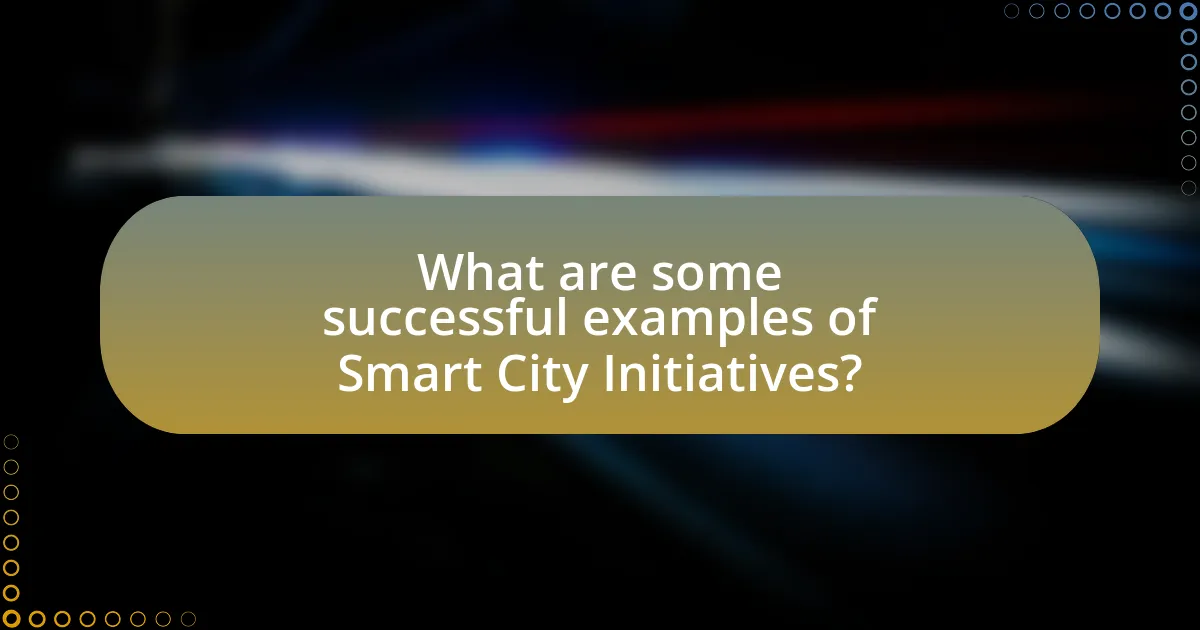
What are some successful examples of Smart City Initiatives?
Successful examples of Smart City Initiatives include Barcelona’s smart lighting system, which reduces energy consumption by 30%, and Singapore’s Smart Nation program, which integrates technology for efficient urban planning and transportation. Barcelona implemented smart streetlights that adjust brightness based on pedestrian activity, leading to significant energy savings and enhanced public safety. Singapore’s initiative utilizes data analytics and IoT to optimize traffic flow and reduce congestion, contributing to lower emissions. These initiatives demonstrate effective applications of technology in urban environments to address climate change challenges.
How have cities like Barcelona and Singapore implemented these initiatives?
Barcelona has implemented smart city initiatives for climate change mitigation through the integration of IoT technology in urban management, enhancing energy efficiency and reducing emissions. For instance, the city has deployed smart sensors to monitor air quality and traffic, allowing for real-time data analysis that informs urban planning and public transport optimization. Additionally, Barcelona’s “Superblocks” initiative reduces car traffic in certain areas, promoting pedestrian and cyclist access, which has led to a reported 21% decrease in pollution levels in those zones.
Singapore has similarly embraced smart city initiatives by utilizing a comprehensive data-driven approach to urban sustainability. The city-state has implemented the Smart Nation program, which includes smart grids and energy-efficient buildings, contributing to a 36% reduction in greenhouse gas emissions per capita since 1990. Furthermore, Singapore’s extensive use of green infrastructure, such as vertical gardens and green roofs, enhances urban biodiversity and mitigates heat, demonstrating effective climate adaptation strategies.
What specific projects have shown significant results?
The smart city initiative known as the “Barcelona Smart City Project” has shown significant results in climate change mitigation by reducing energy consumption in public buildings by 30% through the implementation of smart lighting and energy management systems. Additionally, the “Songdo International Business District” in South Korea has achieved a 40% reduction in carbon emissions compared to traditional urban developments by integrating sustainable design and advanced technology for waste management and transportation. These projects exemplify effective strategies in urban planning that contribute to climate resilience and sustainability.
What lessons can be learned from these case studies?
The lessons learned from case studies on smart city initiatives for climate change mitigation include the importance of integrating technology with urban planning to enhance sustainability. These initiatives demonstrate that data-driven decision-making can optimize resource management, reduce emissions, and improve the quality of urban life. For instance, cities that implemented smart grids and energy-efficient buildings reported a significant decrease in energy consumption, with some achieving reductions of up to 30% in carbon emissions. Additionally, community engagement in these initiatives has proven essential, as cities that involved residents in planning processes saw higher adoption rates of sustainable practices. These findings underscore the necessity of collaboration between government, technology providers, and citizens to effectively address climate challenges in urban environments.
What innovative practices are emerging in Smart City Initiatives?
Innovative practices emerging in Smart City Initiatives include the integration of Internet of Things (IoT) technologies for real-time data collection and analysis, which enhances urban management and resource efficiency. Cities are implementing smart grids that optimize energy distribution and reduce waste, as seen in Barcelona’s energy management system, which has led to a 10% reduction in energy consumption. Additionally, the use of AI-driven traffic management systems, like those in Singapore, improves traffic flow and reduces emissions by up to 15%. Urban green spaces are being enhanced through smart irrigation systems that conserve water, exemplified by the initiatives in Los Angeles, which have reduced water usage by 30%. These practices collectively contribute to climate change mitigation by promoting sustainability and resilience in urban environments.
How are cities utilizing green infrastructure in their plans?
Cities are utilizing green infrastructure in their plans by integrating natural systems into urban design to enhance environmental sustainability and resilience. For example, cities like New York and Philadelphia have implemented green roofs, permeable pavements, and urban forests to manage stormwater, reduce urban heat, and improve air quality. According to a report by the American Society of Civil Engineers, green infrastructure can reduce stormwater runoff by up to 80%, demonstrating its effectiveness in mitigating flooding and improving water quality. Additionally, the use of green spaces has been shown to increase biodiversity and provide recreational opportunities, contributing to overall urban livability.
What role does community engagement play in innovation?
Community engagement is crucial in driving innovation, particularly in the context of smart city initiatives for climate change mitigation. Engaging the community fosters collaboration, ensuring that diverse perspectives and local knowledge inform the development of innovative solutions. For instance, research by the National League of Cities highlights that cities with active community participation in planning processes are more likely to implement effective sustainability initiatives. This involvement not only enhances the relevance of innovations but also increases public support and adoption, as residents feel a sense of ownership over the solutions.
What best practices can cities adopt for effective Smart City Initiatives?
Cities can adopt several best practices for effective Smart City Initiatives, including stakeholder engagement, data-driven decision-making, and sustainable infrastructure development. Engaging stakeholders ensures that the needs and perspectives of residents, businesses, and local organizations are considered, fostering community support and collaboration. Data-driven decision-making involves utilizing real-time data analytics to optimize resource allocation and improve urban services, which has been shown to enhance efficiency and reduce costs. Sustainable infrastructure development focuses on integrating green technologies and renewable energy sources, which can significantly lower carbon emissions and promote environmental resilience. For instance, cities like Barcelona have implemented smart lighting systems that reduce energy consumption by up to 30%, demonstrating the effectiveness of these practices in achieving climate change mitigation goals.
How can cities ensure inclusivity in their climate strategies?
Cities can ensure inclusivity in their climate strategies by actively engaging diverse community stakeholders in the planning and decision-making processes. This engagement can be achieved through public forums, surveys, and partnerships with local organizations that represent marginalized groups. Research indicates that inclusive climate strategies lead to more equitable outcomes; for example, the 2021 report by the United Nations highlights that cities that involve underrepresented communities in climate action planning are more successful in addressing local needs and vulnerabilities. By prioritizing inclusivity, cities can create climate strategies that reflect the voices and needs of all residents, ultimately enhancing resilience and effectiveness in climate change mitigation efforts.
What are the key steps for successful implementation and scaling?
The key steps for successful implementation and scaling of smart city initiatives for climate change mitigation include establishing a clear vision, engaging stakeholders, leveraging technology, ensuring data integration, and securing funding. Establishing a clear vision involves defining specific climate goals and aligning them with urban development plans. Engaging stakeholders, including government agencies, private sector partners, and community members, fosters collaboration and ensures diverse input. Leveraging technology, such as IoT and data analytics, enhances decision-making and operational efficiency. Ensuring data integration across various platforms allows for comprehensive monitoring and evaluation of initiatives. Securing funding through public-private partnerships and grants is crucial for sustaining and expanding these initiatives. These steps are supported by successful case studies, such as Barcelona’s smart lighting system, which reduced energy consumption by 30%, demonstrating the effectiveness of these strategies in real-world applications.
